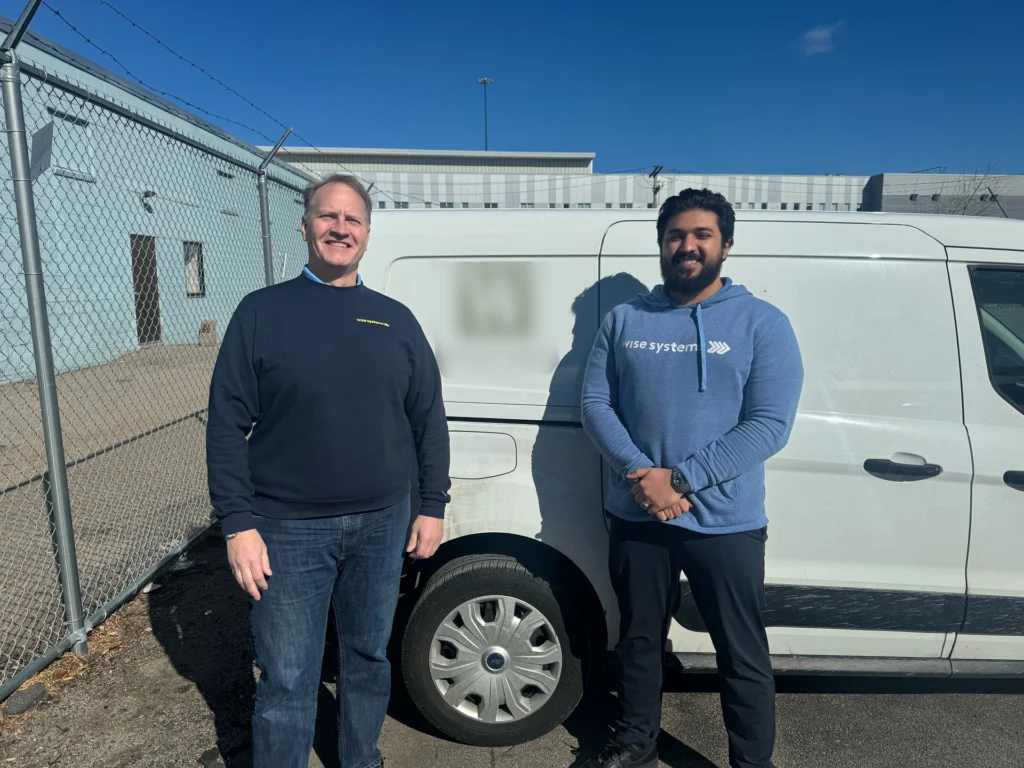Scaling Your Fleet Size for Holidays, Events & Peak Seasons: How to Prepare

Wise Systems

Many industries experience peak seasons that impact deliveries. Peak seasons vary by industry but range from the lead-up to holidays like Christmas or Valentine’s Day for retailers and florists, to flu season and public health crises for businesses handling pharmaceutical deliveries, sporting events and weekends for food and beverage delivery businesses, and more.
Peak seasons are challenging because companies must scale up production and delivery, requiring increased staffing, delivery vehicles, and other assets. In this guide, we’ll explore how one leading flower delivery business successfully scaled its fleet with the help of Wise Systems. We’ll also discuss best practices to prepare your delivery operations and scale your fleet size to accommodate spikes in demand.
In this article:
- What is a Peak Season?
- A Scaling Success Story: From 20 to 135
- Best Practices for Preparing Your Delivery Operations & Scaling Your Fleet Size for Peak Seasons
- Frequently Asked Questions
What is a Peak Season?

A peak season, or peak period, is a specific time frame when demand for services or products significantly exceeds the average, often leading to increased operational activities and challenges for businesses.
These periods can be predictable, occurring at regular intervals (e.g. holidays or specific seasons like the holiday shopping season), or they can be unpredictable, arising from unique events or circumstances (e.g. public health crises like the COVID-19 pandemic). Peak seasons demand strategic planning, resource allocation, and sometimes, operational scaling to meet the heightened demand effectively.
Last-mile delivery operations experience peaks that align with industry peak seasons. For example:
- eCommerce delivery typically experiences peaks during holiday seasons and major sales events.
- Food and beverage delivery services experience peaks on holidays and special occasions like Valentine’s Day, Mother’s Day, and New Year’s Eve, as well as weekends or major sporting events.
- Grocery delivery services often experience peaks in pre-holiday periods, as consumers are stocking up on groceries for big holiday meals, and during unpredictable events like COVID-19 when consumers take advantage of grocery delivery services to maintain social distancing.
- Pharmaceutical delivery services, like grocery delivery services, often experience peaks during public health crises and during flu season.
- Florists experience peaks on holidays, particularly Mother’s Day and Valentine’s Day.
- Furniture and home appliance delivery often peaks during the post-holiday season or during major sales events. These delivery operations may also experience peaks after tax season when consumers use their tax refunds to invest in significant home purchases.
Businesses and last-mile delivery operations impacted by peak seasons must adopt effective strategies to effectively scale their operations to meet increased demand. This includes hiring temporary staff, optimizing inventory levels, adopting dispatch and route optimization tools, and ensuring that communications with customers are clear and proactive.
With detailed planning and the flexibility to adapt to dynamic market conditions, businesses can successfully navigate peak periods, ensuring customer satisfaction and operational efficiency.
A Scaling Success Story: From 20 to 135

It’s well-known that Valentine’s Day and Mother’s Day are florists’ busiest times of the year. Ensuring timely deliveries is especially crucial during these times, and it requires significant logistical efforts to pull it off.
One local flower delivery business successfully scaled its operations from a fleet size of just 20 vehicles to a 135-vehicle fleet to accommodate the significantly increased demand on Valentine’s Day. The company leveraged the Wise Systems delivery automation platform to streamline operations and navigate the challenges that come with managing a fleet that’s 6x the size of their regular fleet.
Wise Systems offers a number of solutions that support last-mile delivery operations and make it possible to rapidly scale your fleet size:
- Performance Manager: Performance Manager from Wise Systems enables companies to track key fleet performance indicators, such as on-time delivery percentages across the entire fleet, per route, and per driver, visualize driver task volumes to optimize efficiency, compare planned vs. actual routes to enhance performance, and more.
- Route Planner: Route optimization is made simple with Route Planner from Wise Systems. This solution manages multiple route constraints like customer delivery windows and driver availability, while also considering historical data to predict accurate ETAs. With this tool, planners and dispatchers can save hours of time, which is especially crucial for companies rapidly scaling their fleet size.
- Dispatcher: Dispatchers can monitor route execution and respond to last-minute changes and issues in real time, an invaluable tool during periods of peak delivery volume.
- Driver: Delivery drivers are more efficient with Driver from Wise Systems, which enables them to quickly scan packages and collect proof-of-delivery (POD) signatures or photos. List and map views of delivery routes, navigation using the mapping provider of their choice, and the ability to respond to last-minute changes and issues in real-time means drivers have a better experience, too.
- Mobile Manager: Managers and field personnel have essential information at their fingertips with Mobile Manager from Wise Systems. With this solution, users can track deliveries and locate drivers, get up-to-date ETAs, delivery statuses, and route progress, all in real time to ensure that delivery operations are on track.
- Customer Portal: Today’s consumers want to know where their deliveries are and when they can expect them, and Customer Portal from Wise Systems enables delivery operations to meet these expectations with ease. With this solution, businesses can send automated delivery notifications via SMS and email in their brand’s voice, and customers can track their deliveries in real-time—down to a live map view of their driver’s progress—providing an excellent customer experience to boost satisfaction.
Speaking of customer satisfaction, Wise Systems goes the extra mile. To ensure this customer was successfully able to scale their delivery fleet and deliver every flower order on time for Valentine’s Day, Wise Systems put two people onsite to provide new driver training and ensure the scaled-up flower delivery service operated seamlessly.

Best Practices for Preparing for Peak Seasons
If your last-mile delivery operation needs to scale rapidly, follow these tips and best practices to prepare.
Determine if your existing fleet can meet demand
Analyze past performance and demand data during similar peak seasons to more accurately forecast upcoming demand. Be sure to account for current market trends, local events, and holidays that may impact demand.
Based on your projections, determine if your existing fleet can meet anticipated demand or if you’ll need to scale up your assets and resources.
Keep fleet maintenance on track
Scheduling and performing maintenance checks and routine preventive maintenance ahead of anticipated increased demand reduces unexpected delays due to vehicle breakdowns. Have a backup plan in place for unexpected vehicle downtime, such as access to rental vehicles or subcontractor fleets.
Before deploying new fleet vehicles, ensure that they’re in compliance with applicable regulations. It’s also a good idea to conduct compliance checks on existing fleet vehicles.
Address staffing needs
Assess your current workforce to determine if you have enough drivers and support staff to accommodate forecasted demand. If your existing staff is insufficient, consider hiring temporary staff or subcontracting.
Whether your existing staff is sufficient or you’re hiring temporary drivers and support staff, training is vital. Conduct onboarding and training for new hires or subcontractors, and ensure your existing staff are up to date on safety and operational policies.
Leverage technology to optimize your operations
You’ll need fleet management software that can handle the increased data volume and provide real-time visibility into your last-mile delivery operations. Invest in route optimization software, such as Route Planner from Wise Systems, to enhance efficiency, reduce fuel consumption, and ensure on-time deliveries.
Also consider leveraging a robust customer communication solution, such as Customer Portal from Wise Systems, to give customers access to real-time information and ensure customer satisfaction. Choose a solution that enables you to proactively communicate with customers about potential delays or changes in service levels during peak periods.
Tune in to our latest Feature Spotlight to discover how simplified route visualizations and real-time fleet visibility optimize your last-mile. Schedule a demo with us today to learn more about Dispatcher from Wise Systems here! https://t.co/dMPjyYSEZv pic.twitter.com/u1kpYbKkd6
— Wise Systems (@goWiseSystems) April 17, 2023
Careful planning, coupled with the right technology, makes it possible to rapidly scale your fleet size to accommodate sudden increases in demand, whether expected or unexpected. Request a demo today to learn more about how Wise Systems can help your business scale your fleet size with ease and meet customer expectations during your busiest peaks.
Frequently Asked Questions
What is a last-mile delivery fleet?
A last-mile delivery fleet consists of vehicles and personnel dedicated to the final phase of the delivery process, transporting goods from a transportation hub to their final destination. These fleets often includes small, agile vehicles suited for urban environments or residential areas. Last-mile delivery is pivotal for customer satisfaction, emphasizing speed, accuracy, and service quality.
What is peak shipping season?
Peak shipping season refers to specific times of the year when the demand for shipping and delivery services significantly increases, often due to holidays, sales events, or seasonal factors. Common peak seasons include the end-of-year holidays, back-to-school periods, and major sale events like Black Friday and Cyber Monday.
How do you scale last-mile delivery?
Effectively scaling last-mile delivery requires expanding the capacity and efficiency of your delivery operations to meet increased demand. There are several strategies last-mile delivery operations can employ to scale operations, such as:
- Accurate forecasting: Using data analytics to predict demand spikes and prepare operations accordingly.
- Increasing fleet size: Adding more vehicles, subcontracting, or partnering with third-party logistics (3PL) providers to accommodate higher volume.
- Leveraging technology: Utilizing advanced routing and tracking software to optimize delivery routes and times.
- Flexible workforce management: Hiring temporary drivers or using gig economy platforms to flexibly scale the workforce as needed.
- Customer communication: Enhancing transparency with customers about delivery times and statuses to manage expectations.
What is optimal fleet utilization?
Optimal fleet utilization is the efficient use of all available fleet resources to achieve maximum productivity with minimal idle time and costs. This involves ensuring that each vehicle is used effectively (not overused or under-utilized) to extend the lifecycle of the fleet, reduce operational costs, and meet delivery KPIs. It also requires continuous analysis and adjustment to adapt fleet operations to meet changing business needs and customer expectations.

